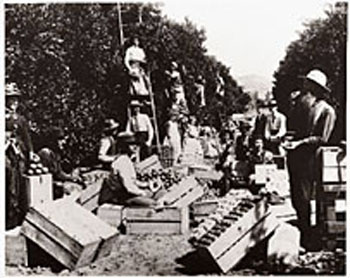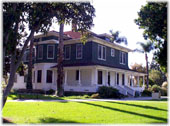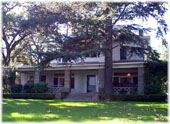|
THE
HISTORY

Packing
fruit in the groves, circa 1880
photo courtesy of oc.book.com
Placentia - Latin for "a pleasant place"
- has retained the small town image that has remained
since settlers arrived more than 100 years ago.
After
it was incorporated in 1926, Placentia was known
as the "baby city," - the smallest in
Orange County.
Despite
its diminutive size, Placentia is where the county's
lifeblood and namesake - the Valencia orange -
first took hold. Although Orange founder Alfred
B. Chapman imported the first Valencia orange
trees, it was on Placentia soil that the first
commercial grove was planted in 1880.
Like
many other Orange County towns Placentia has been
transformed from an agricultural area where residents
worked their own land to a bedroom community where
most residents leave the city to work. A few vestiges
of the old lifestyle (notably small orange groves
scattered throughout the city) remain, but most
of the groves already are doomed to make way for
further development.
Legend
has it that Sarah Jane McFadden, wife of William
McFadden (one of the town's earliest residents)
named Placentia in 1879, but no one is sure how
she came up with the name. There already were
several towns names Placentia, including one in
Newfoundland, Canada, one in Maine and one in
ancient Rome.
Earlier,
Daniel Kraemer started the influx of settlers
to Placentia in 1865, when he purchased 3,900
acres of a land grant made in 1837 to Juan Pacifico
Ontiveros.
Ontiveros'
grant covered what now is Anaheim, Brea, Fullerton
and Placentia, and Ontiveros lived in an adobe
home he built near the intersection of today's
Crowther Avenue and Kraemer Boulevard. The adobe,
which had been the oldest continuously occupied
residence in Orange County, was destroyed in the
late 1970s to make way for development.
Kraemer
bought some of the Ontiveros land and moved into
the adobe, and other settlers soon began moving
in, including the McFaddens.
Crops
at first included walnuts, vegetables and "poorer
qualities of oranges," but in 1880 Richard
Gilman planted the first commercial Valencia orange
grove in the county on his ranch in east Placentia.
The Valencia orange became the major crop in the
county - eventually contributing to the county's
name.
Although
the disease know as "quick decline"
wiped out orange groves in entire area cities,
it was the population explosion in the 1950s,
'60s and '70s that effectively ended Placentia's
orange-packing business.
Oil
also played a part in Placentia's history. The
Union Oil Co. discovered oil in 1919 on C.C. Chapman's
land in northeast Placentia, and Samuel Kraemer,
Daniels' son, also found oil on his property.
This led to Placentia's first population boom.
Historical
Sites:
 The
A.S. Bradford House - 136 Palm Circle The
A.S. Bradford House - 136 Palm Circle
The home of Albert Bradford was built in 1902
on his Tesoro Rancho. He was one of the founders
of Placentia and organized Placentia National
Bank and Bradford Packinghouse.
Ontiveros
Adobe Site - Near the corner of Crowther Avenue
and Porter Way
In 1841, Juan Pacifico Ontiveros, owner of Rancho
SAn Juan Cajon de Santa Ana, built an adobe on
this site. His holdings included land that became
the Anaheim colony, as well as the later
town sites of Placentia and Fullerton. The adobe
no lon ger
exists. ger
exists.
The
George Key Ranch - 625 W. Bastanchury Rd.
The oldest standing house in Placentia, it was
built in 1898 and remodeled in 1908. Key was superintendent
of the Southern California Semi-Tropical Fruit
Co. The house is not open to the public.
|


![]()




